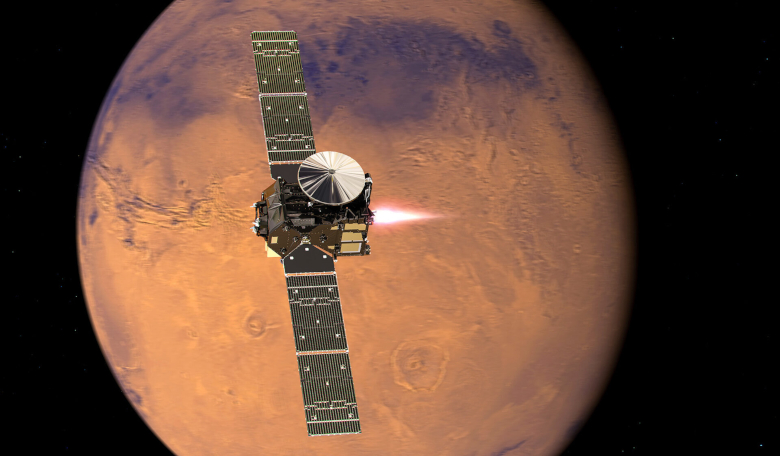Just as Mars’ becomes swamped by a raft of new spacecraft sent to study the planet, scientists using the ExoMars Trace Gas Orbiter have uncovered some tantalising new discoveries.
Detailed in two separate studies published this week in Science Advances, one international team have observed water vapour escaping high up in the planet’s thin atmosphere, while another has found hydrogen chloride—the first time that the Orbiter has detected a new gas.
ExoMars is a joint ESA-Roscosmos programme comprising of two missions: the first – the Trace Gas Orbiter – launched in 2016 whereas its rover and surface platform counterpart is slated to launch in 2022.
In its quest to hunt for atmospheric gases linked to biological or geological activity, the Orbiter has already enabled scientists to detect a ‘glowing’ thin green layer of gas hugging the planet and has uncovered clues to help to solve the methane mystery on Mars. But now it could be about to determine whether the Red Planet could ever have been habitable.
It is no secret that Mars is riddled with geological features that suggest liquid water once flowed across its surface. Now though, most of that water is either buried underground or locked up in the planet's ice caps.
However, a recent analysis of the deuterium to hydrogen ratio (D/H) in water (deuterium is a stable isotope of hydrogen) has revealed that some of that water is leaking from the atmosphere in the form of hydrogen gas.
"The deuterium to hydrogen ratio, D/H, is our chronometer—a powerful metric that tells us about the history of water on Mars, and how water loss evolved over time. Thanks to the ExoMars Trace Gas Orbiter, we can now better understand and calibrate this chronometer and test for potential new reservoirs of water on Mars," says Geronimo Villanueva of NASA's Goddard Space Flight Center and lead author of the new result."
The escaping vapour was spotted by a team using an instrument called the Nadir and Occultation for Mars Discovery (NOMAD), who used the instrument to analyse light passing through the Martian atmosphere.
"This fantastic instrument is giving us a never-before-seen view of water isotopes in the atmosphere of Mars as a function of both time and location," says Manish Patel, one of two scientists at the UK’s Open University involved in the study.
Meanwhile, a different team headed by Oleg Korablev, at the Space Research Institute (IKI), Russia have identified hydrogen chloride gas, or HCl on the martian surface.
Clorine- or sulphur-based gases are of particular interest to scientists as they are possible indicators of volcanic activity. However the HCl found by Korablev and colleagues was detected in different locations at the same time indicating that volcanoes were not behind the source.
Instead the discovery, which first became apparent in 2018 after a global dust storm swept across the planet, suggests an entirely new surface-atmosphere interaction driven by the dust seasons on Mars that had not previously been explored.
"We've discovered hydrogen chloride for the first time on Mars. This is the first detection of a halogen gas in the atmosphere of Mars, and represents a new chemical cycle to understand," says Kevin Olsen from the University of Oxford, UK, one of the lead scientists of the discovery.
The team suggest that dried up salts left over from evaporated oceans, are being lifted into the martian atmosphere by winds. The sodium chloride dust then reacts with molecules containing hydrogen to create hydrogen chloride.
"You need water vapour to free chlorine and you need the by-products of water — hydrogen — to form hydrogen chloride. Water is critical in this chemistry," Olsen says, who added that the team observed a correlation between hydrogen chloride production and increased dust activity; a process linked to the seasonal heating of the southern hemisphere.
This analysis links the generation and decline of the hydrogen chloride gas to the surface of Mars, say the team but extensive laboratory testing and new global atmospheric simulations will be needed to better understand the chlorine-based surface-atmosphere interaction.
The discovery of the first new trace gas in the atmosphere of Mars is a major milestone for the Trace Gas Orbiter mission," says Håkan Svedhem, ESA's ExoMars Trace Gas Orbiter project scientist.
"This is the first new class of gas discovered since the claimed observation of methane by ESA's Mars Express in 2004, which motivated the search for other organic molecules and ultimately culminated in the development of the Trace Gas Orbiter mission, for which detecting new gases is a primary goal."











